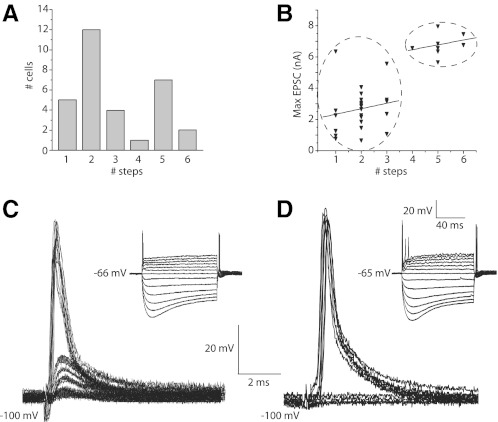Fig. 4.
Bushy cells fall into 2 distinct groups; bushy cells that fire 1 action potential have more inputs than those that fire multiple action potentials. A: histogram of the estimated number of inputs of bushy cells is bimodal consistent with bushy cells falling into 2 groups. One group, 60%, received input from ≤3 inputs, whereas another group, 40%, received input from ≥4 fibers. B: the bushy cells that had most inputs tended to have the largest maximal EPSCs. K-means cluster analysis indicated that the amplitudes of maximal EPSCs fell into 2 groups indicated by the ovals (P < 0.05). C: bushy cell with 4 inputs fired a single action potential when depolarized with current. Synaptic responses to shocks that were increased in small increments showed 4 steps in rising slope and amplitude. Excitatory postsynaptic potentials (EPSPs) were recorded when the cell was hyperpolarized to −100 mV to increase their resolution. Under these conditions, 3 steps were subthreshold and a 4th brought the cell to threshold, giving the cell a total of at least 4 inputs. Inset: responses of the same cell to a family of current pulses from +0.6 to −0.6 nA that changed in 0.1 nA increments. The bushy cell fired only a single action potential no matter how strongly it was depolarized. D: bushy cell with 2 inputs fired 3 action potentials when depolarized with current. The slope of the foot of the EPSP in this cell grew in 2 steps as the shock strength was increased in small increments. Inset: current pulses in this bushy cell evoked 3 action potentials. The larger responses to current pulses than in C reflect a higher input resistance.

